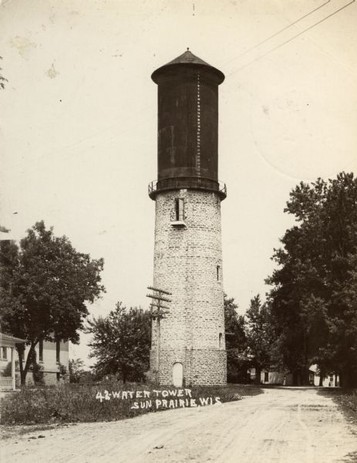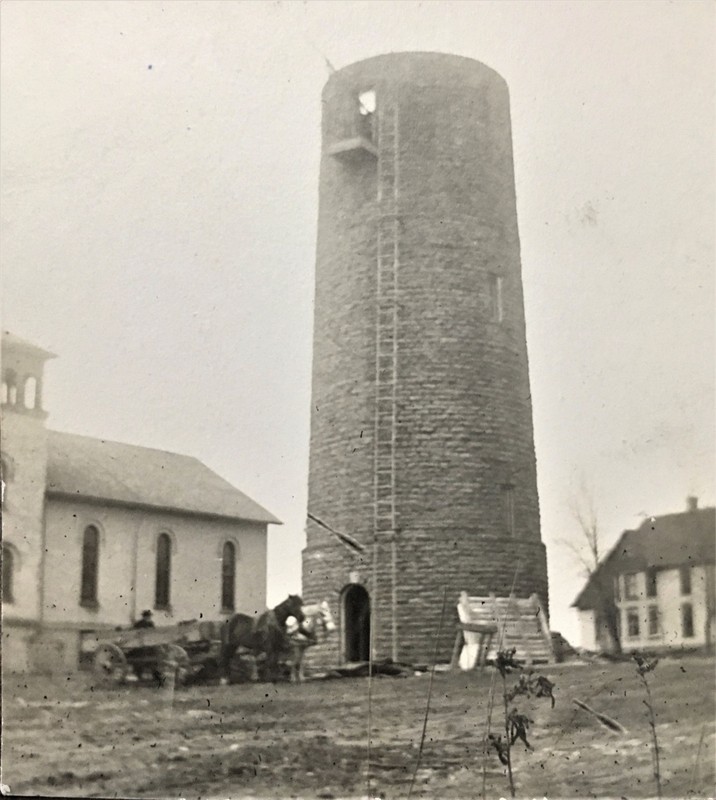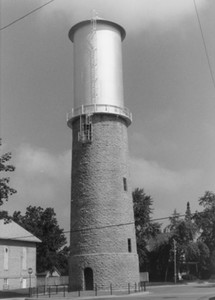Sun Prairie Water Tower
Introduction
Text-to-speech Audio
Standing at the apex of the hill overlooking downtown sits Sun Prairie’s first water tower, erected in 1899 and used until 1991. The stone tower stands 60 feet tall with walls 2 feet thick at street level, tapering to 1 foot thick at the top. The structure is a rare example of its type in Wisconsin and was crafted using local dolomite limestone salvaged from the mid 1800s Stevens Grist Mill located on the Maunesha River, five miles to the northeast. The base supports a 30-foot-high steel tank that was added to the tower in 1912, replacing an original wooden version. Local volunteer and donation efforts provided for the restoration and preservation of the tower and its rededication in 1995. The structure was placed on the National Register of Historic Places in 2000.
Images
Early Photo of Tower and Columbus Street Area

Tower Under Construction

Modern Photo

Backstory and Context
Text-to-speech Audio
First settled in 1839, Sun Prairie by 1898 had developed into a village of some 1100 residents. A financial depression earlier in the decade had receded and the village was taking on deeper roots with a new city hall, brick blocks with hotels and many new residences having been constructed. The first fire company was organized in 1891 and was now housed in the city hall that included a 1000-gallon water tank in the basement for use in firefighting. A franchise had been issued for private operation of electric lights and telephones in the town and attention turned toward establishment of municipal waterworks in the community as the next step in modernization and improved fire protection.
With a contemporary perspective, it is interesting to see how quickly the plans for the water tower and associated works came to fruition. In February 1899, an ordinance proposal was made to franchise construction and operation of waterworks including a steel tank on a steel substructure with 30 hydrants. However, by March of that year sentiment had turned toward a plan for municipal ownership of the works through a $12,500 bond issue and new system specifications were also developed that now included a stone tower in the design. Political progress on the project slowed for several months, but a June fire that burned through a saloon and restaurant in town served to reignite the cause. Sun Prairie’s citizens held a final vote in early August and by a 117 to 95 vote margin, the ordinance to build the water tower and associated water works was approved. Bonds were released for bid later the same month and an offer from the locally owned First National Bank of Columbus was accepted for financing over 14 years at a 3½ % interest rate.
Construction of the water tower began in October 1899 on high ground north of the city center, at the junction of Church and Columbus (formerly Center) Streets. The local firm of Stegerwald and Lessner won the contract for the stonework at a bid price of $1,750 and used dolomite limestone salvaged from the Stevens Grist Mill site, formerly located near where the Maunesha River now crosses Highway 151. Rough-cut blocks forming the 60’ tower are described as “unusually uniform, giving the tower an appearance of solidity and finish” and rise from a 2’ rusticated stone foundation that is now almost entirely below street level. The outside diameter at the foundation is 25' with blocks that are approximately 8" in height and up to 2' in length in the base. A 30’ high, 20’ diameter steel tank sits atop the tower capable of holding 70,000 gallons and replaced the original 25’ high wooden tank in 1912. The tank and its connection pipe can be accessed from within the tower via a round-arched door formed with radiating blocks, with a center arch keystone inscribed "1899."
Associated with establishment of the tower, construction of the water work utilities included 2 miles of piped mains ranging from 4” to 8” diameter along with 22 double fire hydrants situated throughout the town. A 22’ by 30’ main pump house was built to house a gasoline engine powered, Gould Triplex pump capable of providing 240 gallons per minute of water into the system pulled from driven wells. The brick pump house was located down the hill from the water tower near where Market Street currently intersects with E. Linnerud Drive. The Sun Prairie Water Tower and its systems became operational in December of 1899 and just in time; a fire in March 1900 at the nearby Sacred Hearts school would reported have “left it in ashes were it not for the new hydrants nearby.”
The tower remained the primary water storage capacity for Sun Prairie until a modern water tank was built in 1962 and was a notable landmark on the main route north of Madison until the HWY 151 bypass was built in 1959. Modernization of Sun Prairie’s water system and aging of the tower’s equipment made the tower obsolete as a water storage asset and in 1991 it was removed from service. Facing proposed demolition, a citizen group organized the “Columbus Street Water Tower Board” with its goal to save and restore the structure as a significant piece of Sun Prairie’s history. With local student and community support, funds were raised through sales of commemorative bricks, quilts, mugs and even auction of old city furniture. Along with $19k of city funds originally intended for the demolition, a total of $70k was raised by the Water Tower Board. With further donations of labor, materials and equipment by private individuals and the city, the tower was cleaned and repaired, and a rededication ceremony was held in November 1995.
A visit to the current site will find the tower surrounded by a small plaza named for late alderman Jim Reininger, composed of 690 commemorative bricks sold in association with the restoration campaign. Windows in the tower were replaced and dedicated in honor of Martin O. Feuling, former Post Master of Sun Prairie. The Sun Prairie Water Tower remains city owned and continues to stand as the first Public Works building in Sun Prairie, overlooking the historic downtown district. The tower’s construction, followed closely by electric lights, telephone and sewage systems in the early 20th century, marks the political and social transition of Sun Prairie from a pioneer village to an established town supporting modern municipal facilities.
Sources
Eiseley, Jane. Sun Prairie Water Tower - NPS Historic Place Submission, National Park Service - Registration Form. February 23rd 2000. Accessed May 3rd 2022. https://npgallery.nps.gov/NRHP/GetAsset/4e258c7b-78ae-4bb0-83cf-fe153713f4c2.
Klein, Peter Michael. Sun Prairie's People - Shadows and Dreams. Sun Prairie, Wisconsin. Sun Prairie Historical Library and Museum, 1993.
Sanborn Map Company. "Sanborn Fire Insurance Map from Sun Prairie, Dane County, Wisconsin", November 1899. Accessed December 28th 2021. http://hdl.loc.gov/loc.gmd/g4124sm.g097101899.
